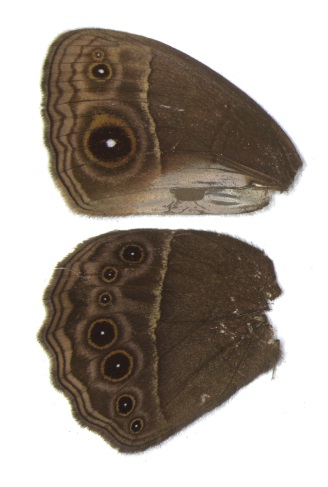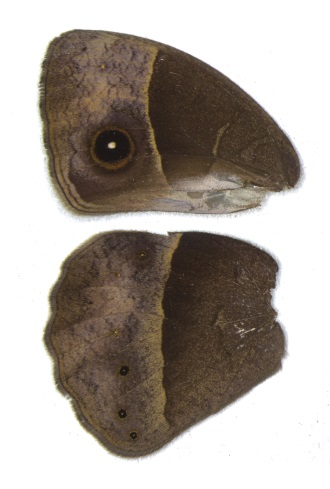About This Project
A key challenge in evolutionary biology is in understanding how morphological diversity is generated through environmental effects – plasticity. Many butterfly species have sex pheromone producing glands called androconia and their development is affected by their environment (wet/dry season). How does this effect come about and what does this mean for their mating success?Ask the Scientists
Join The DiscussionWhat is the context of this research?
In many butterfly species, structures called androconia are involved in the production of male sex pheromones and play a key role in male mating success. What effect does the structure of androconia have on pheromone production? Does overall size of androconia correlate with pheromone production and do individuals with smaller androconia have lower mating success?
Tropical mycalesine butterflies are excellent candidates to explore these questions. Many of these species exhibit striking responses to their environment, with both wing patterning and androconial size strongly correlated with temperature during larval development.
What are the underlying regulatory mechanisms behind these structures and how are they related to hormone signalling during development?
What is the significance of this project?
This work may lead to a better understanding of how the environment can generate plasticity in both sexual behaviour and morphology.
Understanding how this kind of response is regulated may provide vital insights into the genetic and developmental basis of morphological evolution. This work may also help forward our understanding into how species may react to future environmental challenges, such climate change.
What are the goals of the project?
I want to answer some of these questions through a series of behavioural, morphological and physiological experiments:
1) Artificial selection test: I plan on conducting a large scale artificial selection experiment in order to produce males with size androconial wing structures, regardless of eyespot size.
2) Morphology/behaviour analysis: These will be used to test for a correlative effect between androconial size and pheromone production/mating behaviour.
This funding will provide residence in Cambridge which is is vital in supporting the research. The project will form part of my Masters course in Zoology.
Budget
Butterflies are amazing, but to find out the secrets of their sex life, they require constant attention, meaning long hours of animal husbandry. The project will therefore require the residence of a Masters student in Cambridge (me), and travel to and from the facility in Madingley.
Your funding will help pay for costs during the time at Cambridge, including living costs and travel. The funding will be used in the most cost-efficient way possible. These day-to-day costs are vital in supporting the project, without which it may not be able to move forwards.
Meet the Team
Team Bio
Andrew's research is in the area of evolutionary biology and has focused on how visual phenotypes can come about through natural selection. He will be a Masters student at the University Of Cambridge Department Of Zoology during the time of the research.He is a B.Sc. Biology graduate of the University of Leeds, graduating near the top of his class with First class honours. While obtaining his degree, he has worked in zoological research at many levels. His most recent work involved an informative investigation into the evolution of Batesian mimicry. Andrew has also undertaken research in developmental genetics, receiving a Santander cash award. He has also undertaken several research internships at the University of Leeds and Max Planck in Germany.
In addition to his studies he has written science articles for Scientific American and founded a non-profit science organisation: Lu:Sci science magazine. He speaks German, enjoys cooking and stand-up comedy.
Lab Notes
Nothing posted yet.
Additional Information

Image credit:
Mating Bicyclus safitza - Martin Grimm

Adult Bicyclus anynana - Jerry Oldenettel

Caterpillar - Gilles San Martin

Bicyclus anynana wings - wet (above) and dry (below) season form, with noticable differences in eyespot size and number.
- Erik Van Bergen

Project Backers
- 2Backers
- 2%Funded
- $45Total Donations
- $22.50Average Donation
